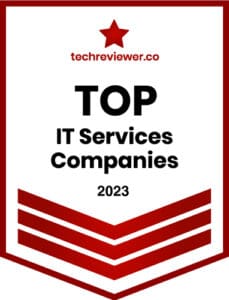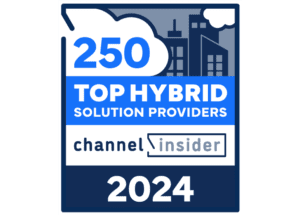A New Webinar Series Focused On Customer Experiences. Listen to it here or read the conversation at the bottom.



Edafio Technology Partners President & CEO Kenny Kinley, and CTO, Keith Woodruff, shared their insight on what it means to go through a successful succession by operating and growing a company based on culture, purpose, and most importantly, its people. They also covered industry topics and trends impacting business operations with Larry Cobrin, MSPCFO CEO and Co-Founder who led the conversation.
Larry Cobrin: I want to welcome, Edafio Technology Partners, Kenny Kinley, President/CEO and Keith Woodruff, CTO and Partner to MSP CFO Conversations. A webinar covering MSP industry topics and trends impacting business operations. Can you share some background about Edafio Technology Partners?
Kenny Kinley: Edafio Technology Partners have been around for over 20 years. We are a managed service provider primarily based in Arkansas. However, we’ve got a few clients in Tennessee and Oklahoma. Edafio was founded in Central Arkansas, and we have offices in North Conway, North Little Rock, and an office in Northwest Arkansas in the Rogers area. Typical managed service work has been our core offering for over 20 years. But, we’ve also got a cloud and cybersecurity practice. We have 109 associates and have been very fortunate to have experienced significant growth over the last ten years.
Larry Cobrin: So, you said three locations and 109 associates, and how much of that growth was organic versus mergers and acquisitions?
Kenny Kinley: It was all organic.
Larry Cobrin: Okay, to frame what we’re talking about is a company that’s had a fair amount of growth over 20 years and who have been around the block one or two times. A company has experience with different issues right now as a mature MSP in multiple markets instead of a three or four-person shop, but that is a journey you have enjoyed.
Kenny Kinley: I think I was associate number 12 or 13 back nine years ago, and Keith was there a few years before me.
Keith Woodruff: Yeah, I think I was associate number 11, and we’ve been fortunate to bring on some great talent with our company in the past ten years Kenny, indeed, being a key part of that. And we’ve had just phenomenal growth and success.
We also like data to help us make decisions. We’ve been using MSP CFO for a few years, which helped us understand some profitability or challenges at the client level. We are not intending to put a plug in for you, but your tool has been beneficial for us and how we run our business.
Larry Cobrin: Let’s talk a little bit about this. Not about the product but about going from the journey between the two of you going from employee number nine to where you are today – to where you will be in a year.
Kenny Kinley: Do you want to give the history, and then I can add on a little more about the future.
Keith Woodruff: Sure. When I joined the company, we didn’t have much of a salesforce at all. We had a gentleman who was in the sales role, and when he stepped out of the role. Kenny and I had worked together for 10 to 15 years previous to that at a company called Axiom, and we were good friends. I knew we needed another sales-oriented guy, which I am not. I’m an engineer by background. I knew we needed someone like Kenny, and I wanted Kenny to come to join our team. And it just so happened that we caught him when he was ready to move into a different role from the company he was at. When I hired Kenny, I knew that he would make a huge difference to our company’s growth because he’s a very talented fellow. And I also knew that he would be in the succession plan and that he would be someone who could fill my shoes. I’m 63 years old, and Kenny is 18 years younger than I am. I knew that for the long haul, our company needed someone to replace me, and Kenny would be the perfect guy to do that. So fast forward ten years, we’ve done that transition. Kenny moved into the CEO president role on January one of 2020. Just in time for COVID, along with all the challenges and stress it brought! And he has done a great job doing that.
Larry Cobrin: One of the questions I have is talking to many customers going through their journey, growing from the two-person shop to hiring managers, and starting the transition. If you read any trade journals, the transitions more often than not are about private equity. Can you talk a little bit about how you decided to make the transition internally? And then – how you think the skill sets evolved and the skill sets required from building the company to where it is to manage it to its next phase of growth? How that the transition works?
Kenny Kinley: I’ll take a shot at that, Keith. When I think back to 10 years ago, it was a company with a dozen people with a lot of great engineering talent. They were guys who knew everything about the technology for our specific clients. What we have had to do to scale and grow is to be a little more specialized. Our primary engineers would own the client relationship in the early days and do all the technical support. And it was a one-stop-shop and what we realized is, you know, that was not going to scale. We knew we had to invest in bringing on account management to help manage those client relationships renewals, upsell, and be the client advocate. Watching this engineering space explode and to where you’ve got to have network engineers, systems engineers, and cybersecurity consultants.
What we’ve seen over the last ten years is it’s too complicated not to be able to specialize in areas. We are privately owned, and we don’t have those private equity pressures that many larger MSPs have. We were able to invest and get our ownership group to buy in on investing in sales, additional leadership for our network team, systems team, and cyber team. I attribute a lot of our success to investing in those key areas, and it’s paid off well for us.
Keith Woodruff: I think the one thing that I would add to that is we decided, or rather it evolved for us, that we became specialists in the healthcare space. About 60 to 70% of our business is with healthcare clinics and hospitals. And about that time, the Affordable Care Act and EMRs became mandated. There was some fair amount of technology and complexity that many of these organizations needed help with, so we could go in and help them with the transition to electronic medical record systems. We specialize and provide healthcare and security consulting, in addition to doing their IT infrastructure work. One of the differentiators is having a deep understanding of the tech industry for a big chunk of our clients and helping them navigate the complexities technology brings.
Larry Cobrin: On that note, obviously managing a company, your size has some drudgery. Looking at health insurance presentations accurately is not the most fun part of your job. What do you still have a passion for with the business at this scale? What problem do you face that gets you excited about getting your teeth into?
Kenny Kinley: I think that’s part of why Keith and I work so well together. We’re wired differently. For me, it’s about client relationships and helping clients solve problems. If we are now, which is primarily Arkansas-based, how do we take this great work that we do for these clients and replicate that in Tennessee or Oklahoma? How do we serve clients in those areas as well? My passion areas are how we can continue to grow and cultivate great relationships. We don’t think of ourselves as is an IT vendor. We want to be a strategic partner and helping them with their technology is a big part of all businesses. Now we want to be that partner so that that’s what excites me.
We want to be a strategic partner and helping them with their technology is a big part of all businesses. Now we want to be that partner so that that’s what excites me.
Kenny Kinley
Keith Woodruff: Larry, I think, as leaders of companies, one of the most important things we can do is establish a culture. I love Peter Drucker’s quote: “Culture eats strategy for breakfast.” It’s committed to our client’s success. Unquestionable integrity and operating as one-team with humility and respect. These apply to how we operate internally as well as with our clients. So in terms of my passion, I don’t feel like it’s changed since I joined the company. It’s to practice those values and do it well, and it is what I’m still passionate about today. The beauty of that is we do them, and we talk about them. It’s not just something that hangs on the wall. We encourage our associates to share core value stories in all of our meetings. We apply them when we interview candidates. We’ve been able to attract some talented people who share those core values and get excited when they realize that, hey, this isn’t just something that is on a wall. It’s something that’s real people. And so, I guess that’s the thing that I’m still passionate about is us sticking with those core values.
Larry Cobrin: There’s a question that came in from the audience. Can you explain why you felt that having generalist engineers vs. specialists wasn’t scalable?
Kenny Kinley: I think it was when technology changed. We went from the days of having a systems engineer who understood how firewalls worked to now; there’s more specialization around wireless, firewalls, routers, phone systems, and more. As the technologies advance and the certification requirements mandated by our vendors, we’ve just seen the need to concentrate on that. It’s hard. It goes back to our core values that Keith mentioned one-team with humility and respect. Instead of one or two people touching the client, it may take six because we have specialists in more technology areas. We found that to go deep and stay on top of technology, we have to hire people with specific skills. People tend to have more specialized interests. We also have to do it from a recruiting perspective.
“Culture eats strategy for breakfast.” It’s committed to our client’s success. Unquestionable integrity and operating as one-team with humility and respect. These apply to how we operate internally as well as with our clients.
Peter Drucker
Keith Woodruff: I think the only thing I would add to that is, whether you’re a generalist or specialist depends upon where you sit. We have guys who specialized in networking, but they’re in some ways they may have been a generalist and around, networking topics, and then we may have some people that go deep and checkpoint firewalls, for example. Some of our people would call themselves generalist networking skills and capabilities. I don’t want to give the impression that our people are really narrow and very specialized in only one area because there has to be some level of generality because of our clients’ different needs and environments.
Larry Cobrin: No, it does. Another question is, with your engineers. They are different people doing different jobs at different levels. How do you measure the quality of your associates?
Kenny Kinley: I think we looked at that multiple ways, so one is just from a productivity standpoint, such as billable hours. We’ve got billable hour targets for our associates based on the job role and the clients they support, so there’s a kind of objective perspective. We have our quarterly rocks. We’re operating on the EOS Traction system, so each person has quarterly rocks assigned to them. That’s another measure of success.
Did you accomplish the 3, 4, or 5 rocks assigned to you?
The other big thing we do that we’re incredibly proud of is our review process; we rank our people according to our core values. When you do an annual review, part of that process is not just compensation, but how are you performing against the core values that we’ve set? I’d say those are some of the primary ways we measure success.
Larry Cobrin: Do you ever find there is a divergence between somebody who is quantitatively productive or quantitatively unproductive? And if you look at that one more way from a culture/values perspective, are they hitting the target. What kind of person hits the target on one end but misses on the other? Or do most people if they fit the culture, they’re probably doing the job right.
Kenny Kinley: More times than not, it works. I think that’s sometimes the challenge, and that’s why our hiring process against these core values is so important; we have a very much an onsite presence with our clients. I mean, most of our professionals go onsite. Some are onsite with clients five days a week, and some are onsite one day a week. We try to do a good job on the front end when hiring to ensure that they have the technical skills and have relationship skills with the client and other team members. When it doesn’t work, it’s typically more on the relationship side than the technical side because we can train on the technical things. What’s important to us is to hire people who meet the core values and communicate well. That’s our secret sauce.
Larry Cobrin: Right. It sounds like the core values are a leading indicator of success, and the billable hours are just a confirmation that good things are working? That’s interesting. On that note, though, if we can talk a little more about the core values, it’s tough to quantify and measure. It’s more of a subjective view, which doesn’t make it not doable, but it’s hard to use metrics. Can you talk a little bit about how and I would think of a company with 100 million viewers and multiple locations with hundreds of compliance and agreements, how you leverage metrics for success? I want to make it clear this is not a discussion about MSP CFO for us. There are other fantastic tools out there. What metrics do you look at, and how do you use them? One of the things that we talk about on our side is the concept of actionable versus information. If you look at your sales every quarter, that’s fantastic to understand how you’re growing, but it doesn’t necessarily tell you there’s a problem if you have a client that there’s a particular practice bear that out. Then you fix that problem. So with that knowledge with that sort of framework. How do you look for actionable metrics to drive either growth, the top line, or growth to the bottom?
Keith Woodruff: It’s in gross margin when we look at a gross margin at the client level. We ask ourselves why we are losing money on this client? Is it because of who we have assigned to them? Is it because we just priced it wrong, or is it because their environment changed? We take that information, and then at the time of renewal, we go back to the client and say we notice your environment’s, changed, and need to adjust your price. And, you know, most clients understand and agree and like the service we’re performing. Still, occasionally, one will say, you know, we’re not willing to pay that, and they’ll go somewhere else, and that’s okay. So I’d say gross margin on the client level is one thing. We also have different types of agreements with clients. We have a fixed price type of agreement. And then we have this other type that’s more of a “block of hours” agreement, and we call it a flex agreement. And so we look at those things as a group of clients that have this type of agreement. They help us understand as well at a macro level, okay, what is it about this set of clients in this agreement that we’re missing? Is it something that we need to tighten up in the contract or statement of work to address a specific issue?
Kenny Kinley: Another thing we have is a weekly scorecard that we look at every Monday. It is a leading indicator – which includes the number of opportunities in the pipeline at a particular stage. We target the number of closed opportunities, upselling of existing clients, and accounts receivable and billable hours. We have ten metrics as part of that EOS tool that we look at every week. If some of those are off or drifting up or billable hours are drifting down or haven’t closed a deal in three weeks, you know we raise those to issues and dig into them. So I think that’s something that we’ve done relatively recently that has helped us kind of say, okay, let’s don’t wait till a month-end or quarter-end and ask why we are off-budget. We should know week by week how we’re doing if we’re looking at those metrics and taking action.
Larry Cobrin: When did you implement EOS?
Kenny Kinley: We started it in January. So we’ve been at it for ten months now.
Larry Cobrin: Many, many companies in our space are embracing EOS, even outside of our space. How would you compare life before EOS where you were metrics based driven to life after or life during EOS?
Kenny Kinley: When we transitioned the CEO role from Keith to me, what I recognize about myself is I’m not as detailed as Keith. What I found is that we needed to implement a framework to keep us on track. For me, it was a structure a methodology that would keep us focused. It’s been perfect to have that rigor and structure to talk about things week in, week out. I’m not going to lie – it’s tough to follow the same schedule every week, but, again, some of that is self-awareness on my part. I mean, we’re following the Level 10 meetings, and we’re doing the quarterly rocks. We’re doing our quarterly planning sessions. I’d say we’re 90% compliant. We adjusted a few things from the traction book, but I think it was perfect for doing something new amid the CEO transition for our team. We have a new leadership team – we have a new VP of Sales and a new VP of Delivery. We’ve changed a lot over the last year. It was the right timing to get us all on the same page and talk to the same language.
Larry Cobrin: Sure. We have about five minutes left, so I want to make this one relatively concise to avoid taking up too much time. What are the top three things you think, whether you’re a five-person MSP or 120 people MSP, that you wish you knew earlier? This is just so fundamental, and it took me a while to get my arms and mind around but is super important. What would you say are your top three things?
Kenny Kinley: I would go back to core values. We can’t underestimate them. I probably undervalued them during my first few years at Edafio. Make those part of your DNA. If you’re not comfortable with it, get some help to set those. I would say EOS is essential.
The other thing is the metrics and making sure you know the numbers. I’m an accountant by trade, and Keith is an engineer. One of the things that came from both of those backgrounds is numbers. Ensure you know things like your margin and watching your A/R. I notice financial activities are a little bit lower in other managed service companies. I suggest that leaders who are not wired that way to get some help. You have got to run your business by the numbers.
Keith Woodruff: I agree with that, and I would add to it. Relationships. Arkansas’s a tiny community, and when we do something well for a client, and one of their peers comes and says, “Hey, we’re having trouble with our IT.” And our client says, “We love these guys at Edafio. They care about our business, and they’re committed to our success. They will do a great job. You need to give them a call.”
So, a fair amount of our growth has just come from people in the community who have businesses that either knows us individually or know one of our clients. Having a good reputation in our market space with people who like and trust our work and dedication to success. I think it has been a real key.
Larry Cobrin: Did you guys self-implement EOS, or did you hire an outside consultant?
Kenny Kinley: We started with a consultant. I put a plug in for Dusty Pruitt; he is excellent. He’s located in Northwest Arkansas, but he covers several states, but he helped us with our first three days and then conducted a couple of our quarterly planning sessions. We’ve got a reliable leadership team, so we moved to self-maintenance mode. I would recommend starting with a consultant; there’s a lot of good ones out there. And then, you could do it yourself, but I’d start with one for sure.
Larry Cobrin: I want to throw in a comment from somebody who typed in from over in the UK, and he said that what you, first of all, I said very nice things about you too, which is always nice to hear. Everything he said rings true with what he has done, and he went the private-equity route. I believe he was written up in the paper today made another acquisition at the company.
He said they follow this culture and the approach, and I have known this company for some time. One more question came in. I’m sorry, how do you manage your payout on your bonuses for your taxes – billable hours, agreement, efficiency, certifications. Is it subjective, is it objective, is it formula based? What’s your view on that, and that’ll be our last question.
Kenny Kinley: We’ve been all over the board on this, so I will try to net it out. We do pay for certifications. When our professionals get certifications, we have bonuses tied to them. What we do today is to allocate a percentage of our net income to a bonus pool for our professionals. We used to have it purely math driven based on productivity and efficiency, but there were always exceptions. We allocate that percentage of net income to the professional teams, and our team leaders allocate at their discretion. So if someone did a great job on an internal project to help us with SOC compliance, we don’t penalize them for not working on billable client work, so today, we’re more subjective and let the team leaders allocate that bonus based on what they feel like their team’s done.
Larry Cobrin: One of the things that MSP CFO has is projects that we do, working with C level operations on productivity. But every method of doing it has its pros and cons. You go through a subjective method, and then you have some questions and go through a particular formulaic base method. And then you wonder, are they padding the billable hours or are they working on a nonrevenue onboarding project, and how do you compensate for that? There are ways around it. Nothing’s perfect; nothing is easy; you want to make sure your employees feel appreciated and want to stay around. They want to strive to be more productive, and there are many ways to arrive at that solution.
Again, thank you guys both, and we’ll talk soon. Thank you. Goodbye.







